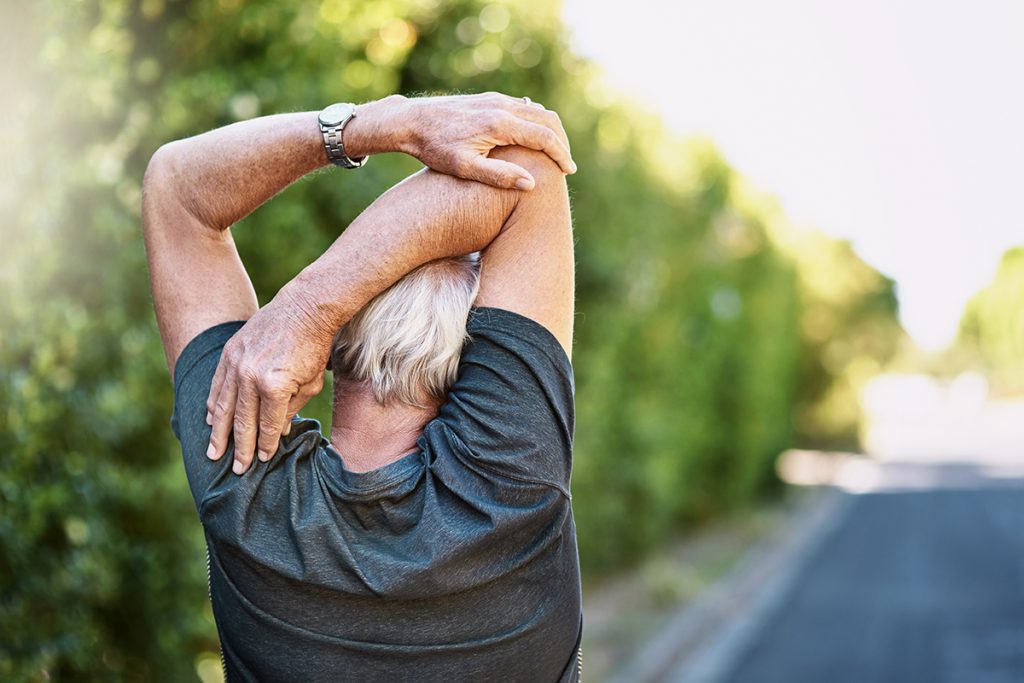Dynamic vs. Static Stretching: Why, When, and How to Use Both
Warm up (and wind down) your muscles the safe way with these 11 dynamic and static stretches.

Love them or hate them, stretches are an integral part of any fitness routine. The American Council on Exercise (A.C.E.) notes that regular stretching can decrease stress, ward off stiffness and joint pain, improve your range-of-motion, boost muscle function, and keep injuries at bay.
Of course, when to stretch and what stretches to do isn’t always so self-explanatory. That’s because there are two different types of stretches in fitness — both of which deserve a place in your routine: dynamic (or active) stretching and static stretching.
Static stretching is fully passive. That means the muscles are held in a single position that generates tension for a specified period of time (think: touching your toes to stretch your hamstrings or holding your arm across your chest to stretch your triceps and shoulders).
Dynamic stretching, on the other hand, is just that — movements that help stretch the muscles in an active, rather than passive, state. Think of a dynamic stretch as a slightly slowed-down, exaggerated form of a movement you might do in your actual workout, like circling your shoulders or wrists prior to a pickleball game or performing standing marches before a jog.
Here’s a breakdown on when you should practice each kind of stretching, plus ways to incorporate them into your routine.
Get and stay fit with SilverSneakers! Classes and events are happening right now at participating gyms, online through SilverSneakers LIVE, and at community centers near you. Activate your free online account to get started.
When to Use Dynamic and Static Stretching
Getting ready for a workout? Then you should opt for active or dynamic stretching as part of your warmup routine. This type of stretching prior to exercise has been shown to help increase the body’s ability to produce power, enhance performance, and ward off injuries. Dynamic stretching will also help to generate more blood flow to the muscle groups you’re about to work.
Repeating some of the same dynamic movements at a slower pace is also a great way to bring your heart rate down at the end of a workout.
Static stretching, on the other hand, may actually put a damper on your workout performance — and your recovery. An International Journal of Sports Therapy study suggests that static stretches performed right before a jog, aerobics class, or other high-impact workout could momentarily decrease muscle strength. And there is some evidence to suggest that rest, as opposed to actual stretching, might be more beneficial immediately following a workout.
Static stretching is best saved for right before bed or upon rising. Those are the times when these types of stretches can help ease muscle aches and reduce stress.
5 Dynamic Stretches to Try
String these five moves together for a go-to before and after workout routine. Perform each move for about 30 seconds.
As always, safety is key. Get your doctor’s OK before beginning a new exercise program. If you have a chronic condition (including osteoporosis), balance issues, or injuries, talk to your doctor about how you can exercise safely.
Standing 4-Way Hip Circles
How to do it:
- Stand tall, brace your core and shift your weight onto one leg, knee slightly bent. This is your starting position. Hold onto the back of a chair for support, if needed.
- Lift your opposite foot off the floor and slowly kick your leg out to the side. Keep your working leg straight and the motion small; only kick as far as you’re able while keeping the hips level and back upright.
- Bring your foot back to the floor and repeat for a total of 10 repetitions on that leg. Then, kick forward 10 times, inward (you’ll cross your foot across your standing leg) 10 times, and backward 10 times. Repeat on the opposite side.
- Tip: Keep your chest up and focus on moving from the hip. As you kick, think about tightening the hip muscles on the side and back, as well as your inner thighs and quadriceps.
Single-Leg Step Over
How to do it:
- Roll up a small towel, and place it perpendicular to the instep of your right foot. If your feet are shoulder-width apart, the towel basically connects the insteps of both feet. Put your hands on your hips.
- Lift your left foot, and tap your toes on the floor in front of the towel.
- Immediately lift your foot again, and tap it on the floor behind the towel. Keep your weight entirely on your right leg and your hips level.
- Keep tapping in front of and behind the towel for at least 30 seconds, then switch sides and repeat.
Forward Rocks
How to do it:
- Stand tall with your shoulders back, core engaged and your feet hip-width apart.
- Bend your arms at a 90° angle or place your hands on a chair for support, if you need.
- From here, step forward with your left leg, landing on your heel and pressing through to the ball of your foot.
- As you “rock” forward on your left foot, you’ll raise your right heel off the floor.
- See if you can feel a slight stretch in your right hip. If not, then take a slightly larger step forward.
- Pause here, and then rock your left foot back to your starting point, repeat on the other side.
- Continue for 30 seconds.
Pull-Aparts (With or Without Exercise Band)
How to do it:
- Stand tall with your feet hip-width apart and arms extended straight out in front of you.
- If using an exercise band, hold it with both hands. Your hands should be far enough apart that the band is taut, but not stretched tight.
- Draw your shoulder blades together to pull your hands farther apart until your arms are straight out to your sides or as far as comfortable.
- Pause, then slowly reverse the movement to return to starting position. That’s one rep.
- Aim for 10 to 12 reps total.
Seated or Standing Trunk Twist
How to do it:
- Sit or stand tall with your feet hip-width apart and knees slightly bent.
- Roll your shoulders back and down and bring your belly button toward your spine to engage your core.
- Stretch your arms straight out to your sides, hands level with your shoulders in a “T” position.
- Lifting your head and spine toward the ceiling, slowly rotate your torso to the right as far as is comfortable, twist back to center, and then rotate to the left. That’s 1 rep.
- Do 10 to 12 reps.
Note: Twisting exercises may not be safe for those with osteoporosis; check with your doctor. It’s OK to skip this move or replace it with a Standing or Seated Side Bend.
6 Static Stretches to Try
Carve out time each day for the following gentle stretches. Hold each one for 30 to 60 seconds. You should feel some slight tension in each stretch, but if you feel pain or discomfort at any time, stop.
Hip Flexor Stretch
How to do it:
- Stand near a support object with your chest lifted and your feet hip-width apart.
- Keeping a slight bend in both knees and a hand on your support object or hips, extend your left leg back and place the ball of the foot on the floor.
- Gently press down through your left foot and squeeze your left glute to feel the stretch in the front of the left thigh.
- If you feel stable, reach your left hand up and overhead.
- Hold here, and then repeat on the other side.
Make it easier: Perform this stretch with your right glute on a seat, and your left glute off. Place your right hand on the seat or arm rests for support. While keeping your chest lifted, extend your left hip and leg back to feel the stretch.
Hamstring Stretch (Seated or Standing)
Subscribe to our newsletter
It's quick and easy. You could be one of the 13 million people who are eligible.
Already a member? Click to discover our 15,000+ participating locations.
Follow Us
How to do it:
- Sit or stand tall, and shift your weight to your right leg.
- Extend your left leg in front of you with your toes up and your heel on the ground.
- Keep a slight bend in your right knee, and place your hands on your right thigh or your hips.
- From here, keep your chest lifted as you hinge forward slightly at your hips to feel a stretch in the back of your left thigh.
- Hold here, and then repeat on the other side.
Quadriceps Stretch
How to do it:
- Stand near a chair, wall, or tree.
- With your right hand on a support object, grasp your left foot with your left hand and bring your heel toward your glutes.
- Keep your left knee pointing down.
- You should feel the stretch in the front of your left thigh.
- Hold here, and then repeat on the other side.
Make it easier: If you have trouble reaching your foot, loop a towel around your ankle to hold on to as you stretch.
Cross-Chest Stretch (Seated or Standing)
How to do it:
- Sit tall in a chair with your feet flat on the floor. Alternatively, stand tall with your feet hip-width apart.
- Cross one arm in front of your chest and place your opposite hand on your upper (crossed) arm for support.
- If it feels good, you can gently apply pressure to your arm to increase the stretch.
- Hold for 15 seconds, then switch sides and repeat. Do two or three 15-second holds per side.
Overhead Triceps Stretch (Seated or Standing)
How to do it:
- Sit tall in a chair with your feet flat on the floor. Alternatively, stand tall with your feet hip-width apart.
- Raise one arm overhead and bend your elbow to lower your palm between your shoulder blades, as far as you comfortably can.
- Place your opposite hand on your raised elbow for support.
- If it feels good, you can gently press on your elbow to increase the stretch.
- Hold for 15 seconds, then switch sides and repeat.
- Do two or three 15-second holds per side.
Seated Child’s Pose
How to do it:
- Sit in a chair about an arm’s length away from a table.
- Sit back in your seat and stretch your arms out straight so that they are resting on the table.
- Allow your head to hang freely off the table.
- You should feel the stretch in your shoulders and chest. If comfortable, rock gently from side to side.
- Hold here for 30 seconds.
See our additional sources:
Benefits of stretching: American Council on Exercise (A.C.E.)
Activate Your FREE SilverSneakers Online Account
Get hundreds of free SilverSneakers On-Demand videos and stay in touch with us by creating your free online account. You don’t have to be a SilverSneakers member to get on-demand workout videos, health and fitness tips from SilverSneakers, and more.
SilverSneakers members can go to thousands of nationwide gyms and fitness locations, plus take SilverSneakers LIVE online classes led by specially trained instructors and designed for all fitness levels and abilities – at no additional cost. If you have a Medicare Advantage plan, it may include SilverSneakers. Check your eligibility here.
Already a member? Get your SilverSneakers member ID, search for locations near you, and all the health and wellness resources you need by logging in to your online member account here.




